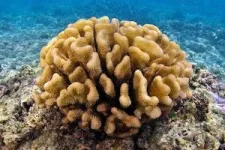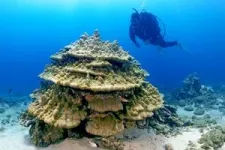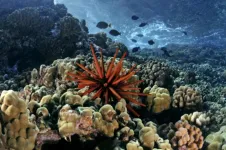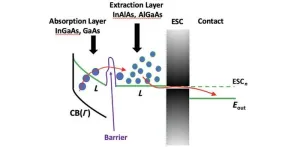(Press-News.org) If you’d stopped monitoring the Adriatic Sea’s marine life in the mid-20th century, the outlook would have been promising. Snails and the clams they hunt for food increased in abundance for several decades during the late 1800s and early 1900s, evidence of a vibrant and healthy ecosystem.
Then, a threshold was crossed. Populations of both predator and prey abruptly plummeted and in some cases disappeared entirely. They were replaced by the common corbulid clam (Varicorbula gibba), which has the ability to slow down its metabolism in unfavorable conditions. Whenever paleontologists find an abundance of this species in the marine fossil record, it often means the environment they inhabited was challenging and unsuitable for other organisms.
“This species became more abundant and grows much larger than it did previously because there are fewer predators and less competition from other species,” said Martin Zuschin, a paleontology professor at the University of Vienna. He and colleagues from Slovakia, New Zealand, Austria, Italy and the United States have published a new study documenting the decline of predator/prey interactions in the Adriatic Sea.
The findings add to a growing body of evidence that shows human activity has dangerously destabilized marine environments in the region. The rapid increase in fishing, bottom-trawling, nutrient runoff, the introduction of invasive species, and warming water temperatures caused by climate change have radically altered marine animal communities along parts of the Italian peninsula.
“From our research in the northern Adriatic Sea, we can say that species composition in these environments is much simpler than it used to be. In many places today, we’re lacking predators, grazers and organisms that live on top of the sediment, while other species, like deposit feeders and animals that live in the sediment, have become more abundant,” Zuschin said.
For a more familiar land-based analog, the northern Adriatic has essentially become the marine equivalent of a golf course, with low biodiversity and excess nutrients. Zuschin and his colleagues have studied the Adriatic’s deterioration for several years by comparing the organisms that currently live there with fossils from those that existed before the arrival of humans in the region.
This type of research, called conservation paleobiology, allows scientists to measure declines in biodiversity and make informed recommendations on how to restore natural areas.
The authors of the current study had the rare opportunity to go a step further. Instead of looking only at declines in the number of individuals and species, they could determine whether the interactions between species were affected as well. This task is virtually impossible with most types of fossils. Physical damage, like bite marks, can be used to study ancient scuffles between predator and prey, but paleontologists seldom find such fossils, and when they do, it can be extraordinarily difficult to determine the type of animal that inflicted the wound.
Seafloor environments are one of the only exceptions to this rule. For as long as there have been marine invertebrates that produce protective outer shells, there have been predators with the ability to bore through them. A variety of marine snails, worms and even octopi have evolved structures to grind and pulverize shells.
“Some snails have specialized organs that secrete acid to soften the calcium carbonate in shells. This makes the drilling process more efficient,” said co-author Michal Kowalewski, the Thompson chair of Invertebrate Paleontology at the Florida Museum of Natural History.
The circular holes left behind are a calling card, which scientists use to quantify predation.
The researchers took samples from two regions, one in the northwest Adriatic along the mouth of the Po River and another in the northeast Gulf of Trieste. At each site, they extracted sediment cores from the seafloor using long, cylindrical tubes. Sediment near the top was younger and had settled onto the seafloor more recently than sediment at the bottom of the tube.
Both locations showed the same pattern. The abundance of predators and prey along with the frequency of drill holes remained consistent until the mid-19th century, when all three spiked. Zuschin says this brief window of frenetic activity is a signature from the early days of Italian industrialization.
“A moderate increase in nutrient input is good for the ecosystem,” he said.
But this grace period didn’t last long. Excess nutrients in the Adriatic fueled the growth of algae, which sank to the seafloor when they died. Bacteria that degraded the dead algae used up much of the dissolved oxygen in the water, which suffocated nearby marine organisms. “It simply became too much, and the whole system crashed,” Zuschin said.
These periods of low oxygen, called eutrophication, weren’t detrimental to everything, though. They may have been beneficial for the common corbulid clam, Kowalewski said. “They’re less vulnerable to lower oxygen levels than some of their competitors, and they can proliferate quickly.”
Corbulid clams also don’t seem to be a favored food source for drilling predators. Their shells are occasionally found with tell-tale holes in them, but at a lower frequency than other species. With their only limitation being how much they can eat, corbulid clams have thrived in the denuded waters of the northern Adriatic.
And there’s another problem lurking on the horizon. Climate change is heating up the Adriatic, which means its water is becoming more stratified. This happens when increasingly warmer water on top mixes less with the colder water below, impeding the flow of oxygen from the surface to lower depths. In areas where eutrophication is already a problem, things are likely going to get worse.
Still, Zuschin says, there’s reason to be optimistic. Efforts are underway to reduce the amount of pollution that makes its way into Italy’s rivers, and samples from one location in the Po River Delta even show a small uptick in drill-hole frequency. Zuschin also warns that restoration won’t be easy and will only get harder the longer it gets put off.
“Environmental degradation is extremely expensive. You cannot even quantify it, because something that is gone that had a tremendous impact on the quality of life cannot be accounted for in terms of money.”
The authors published their study in the Proceedings of the Royal Society B.
END
Fossils from the Adriatic Sea show a recent and worrying reversal of fortunes
Marine predators and their preferred prey are on the decline
2024-09-25
ELSE PRESS RELEASES FROM THIS DATE:
With curtailed carbon emissions, corals can survive climate change
2024-09-25
KANEOHE, HI (Sept 24, 2024 1:05 p.m. HST)- In a study published today in Proceedings of the Royal Society B, researchers at the UH Hawaiʻi Institute of Marine Biology (HIMB) Toonen- Bowen “ToBo” Lab have identified scenarios under which eight of the most common species of coral found in Hawaiʻi can adapt to and survive ocean warming and acidification. The corals in the study are prevalent throughout the Indo-Pacific, a region that comprises more than two-thirds of the coral reefs on planet Earth, and were found to be capable of surviving a “low ...
Global prevalence of short-sightedness in children and teens set to top 740 million cases by 2050
2024-09-24
Around 1 in 3 children and teens around the world is short (near)-sighted, with the global prevalence of myopia set to top 740 million cases by 2050 in this age group, finds a pooled data analysis of the available evidence, published online in the British Journal of Ophthalmology.
Female sex, East Asian or urban area residence, and educational level all seem to be key factors influencing prevalence, the findings indicate.
Short (near)-sightedness (myopia), which describes difficulty seeing objects at a distance, typically starts in early childhood and tends to worsen with age, explain the researchers. It has emerged ...
Urgent rethink of bottled water’s huge and growing toll on human and planetary health
2024-09-24
The huge and growing toll bottled water is taking on human and planetary health warrants an urgent rethink of its use as 1 million bottles are bought every minute around the globe, with that figure set to rise further still amid escalating demand, warn population health experts in a commentary published in the open access journal BMJ Global Health.
Some 2 billion people around the world with limited or no access to safe drinking water rely on bottled water. But for the rest of us, it’s largely a matter of convenience and the unshaken belief—aided and abetted by industry marketing—that bottled water is safer and often healthier than tap ...
Women still missing out on treatment for their No 1 killer—cardiovascular disease
2024-09-24
Women in the UK, and elsewhere, are still missing out on vital treatment for their No 1 killer—cardiovascular disease—despite significant progress in the medical management of heart disease and stroke, concludes a consensus statement published online in the journal Heart.
They continue to be underdiagnosed, undertreated, and underrepresented in clinical trials in all areas of cardiovascular disease, says the statement. Among other things, it calls for dedicated women’s heart champions and heart hubs, plus a women’s ...
Palestinian education ‘under attack’, leaving a generation close to losing hope, study warns
2024-09-24
The ongoing war in Gaza will set children and young people’s education back by up to five years and risks creating a lost generation of permanently traumatised Palestinian youth, a new study warns.
The report, by a team of academics working in partnership with the United Nations Relief and Works Agency for Palestinian Refugees in the Near East (UNRWA), is the first to comprehensively quantify the war’s toll on learning since it began in October 2023. It also details the devastating impact on children, young people and teachers, supported by new accounts from frontline staff and ...
Semaglutide improves outcomes for obese patients with common skin condition, new study shows
2024-09-24
(Wednesday, 25 September 2024, Amsterdam, Netherlands) A pioneering study, presented today at the European Academy of Dermatology and Venereology (EADV) Congress 2024, demonstrates the significant potential of semaglutide in treating hidradenitis suppurative (HS), a common and chronic skin condition, in people with obesity.1
This is the first study to explore the use of semaglutide for HS, marking a critical milestone in the search for effective treatments for this painful and debilitating condition.
HS is currently estimated to affect approximately 1 in 100 people, with obesity being a significant risk factor. The condition is characterised ...
Could GLP1RA drugs lower high iron levels?
2024-09-24
GLP1RA agonists have been increasing in popularity for treating obesity and type 2 diabetes.
With this novel treatment proving to be very effective, researchers are curious to know more about what other potential treatments it could also hold.
Researchers at the University of Michigan investigated another potential way GLP1RA drugs can be useful in treating type two diabetes associated with a genetic condition that causes high levels of iron, called hereditary hemochromatosis.
High iron levels with hereditary hemochromatosis can cause predisposition to liver disease ...
C-Path’s PKD outcomes consortium receives BAA Award for project to advance drug development tools for autosomal dominant tubulointerstitial kidney disease
2024-09-24
TUCSON, Ariz., Sept. 19, 2024 — Critical Path Institute (C-Path) is thrilled to announce its Polycystic Kidney Disease Outcomes Consortium (PKDOC) has been awarded an Autosomal Dominant Tubulointerstitial Kidney Disease (ADTKD) focused Broad Agency Announcement (BAA) contract from the U.S. Food and Drug Administration (FDA). The overarching objective of the work supported by the BAA award is to leverage collaboration with the Wake Forest Rare Inherited Kidney Disease team and its ADTKD registry, to analyze clinical and laboratory data that will help evaluate prognosis in ADTKD and help set the stage for future clinical trials.
ADTKD only affects ...
New insights into hot carrier solar cells: Increasing generation and extraction
2024-09-24
Hot carrier solar cells, a concept introduced several decades ago, have long been seen as a potential breakthrough in solar energy technology. These cells could surpass the Shockley–Queisser efficiency limit, which is a theoretical maximum efficiency for single-junction solar cells. Despite their promise, practical implementation has faced significant challenges, particularly in managing the rapid extraction of hot electrons across material interfaces.
Recent research has focused on using satellite valleys in the conduction band to temporarily store hot electrons before collection. However, ...
Clinical trial results show low-intensity therapy can achieve positive outcomes for certain pediatric leukemia subtypes
2024-09-24
(MEMPHIS, Tenn. – Sept. 24, 2024) – Clinical trial results from St. Jude Children’s Research Hospital demonstrate benefits to using genomics and early treatment response to guide risk classification of children with B-cell acute lymphoblastic leukemia (B-ALL). Traditionally, the intensity of a patient’s chemotherapy regime is guided by the National Cancer Institute (NCI) risk classification, which is largely determined by clinical characteristics such as age and white blood cell count at presentation. Through the flagship St. Jude ...
LAST 30 PRESS RELEASES:
CHANGE-seq-BE finds off-target changes in the genome from base editors
The Journal of Nuclear Medicine Ahead-of-Print Tip Sheet: January 2, 2026
Delayed or absent first dose of measles, mumps, and rubella vaccination
Trends in US preterm birth rates by household income and race and ethnicity
Study identifies potential biomarker linked to progression and brain inflammation in multiple sclerosis
Many mothers in Norway do not show up for postnatal check-ups
Researchers want to find out why quick clay is so unstable
Superradiant spins show teamwork at the quantum scale
Cleveland Clinic Research links tumor bacteria to immunotherapy resistance in head and neck cancer
First Editorial of 2026: Resisting AI slop
Joint ground- and space-based observations reveal Saturn-mass rogue planet
Inheritable genetic variant offers protection against blood cancer risk and progression
Pigs settled Pacific islands alongside early human voyagers
A Coral reef’s daily pulse reshapes microbes in surrounding waters
EAST Tokamak experiments exceed plasma density limit, offering new approach to fusion ignition
Groundbreaking discovery reveals Africa’s oldest cremation pyre and complex ritual practices
First breathing ‘lung-on-chip’ developed using genetically identical cells
How people moved pigs across the Pacific
Interaction of climate change and human activity and its impact on plant diversity in Qinghai-Tibet plateau
From addressing uncertainty to national strategy: an interpretation of Professor Lim Siong Guan’s views
Clinical trials on AI language model use in digestive healthcare
Scientists improve robotic visual–inertial trajectory localization accuracy using cross-modal interaction and selection techniques
Correlation between cancer cachexia and immune-related adverse events in HCC
Human adipose tissue: a new source for functional organoids
Metro lines double as freight highways during off-peak hours, Beijing study shows
Biomedical functions and applications of nanomaterials in tumor diagnosis and treatment: perspectives from ophthalmic oncology
3D imaging unveils how passivation improves perovskite solar cell performance
Enriching framework Al sites in 8-membered rings of Cu-SSZ-39 zeolite to enhance low-temperature ammonia selective catalytic reduction performance
AI-powered RNA drug development: a new frontier in therapeutics
Decoupling the HOR enhancement on PtRu: Dynamically matching interfacial water to reaction coordinates
[Press-News.org] Fossils from the Adriatic Sea show a recent and worrying reversal of fortunesMarine predators and their preferred prey are on the decline






